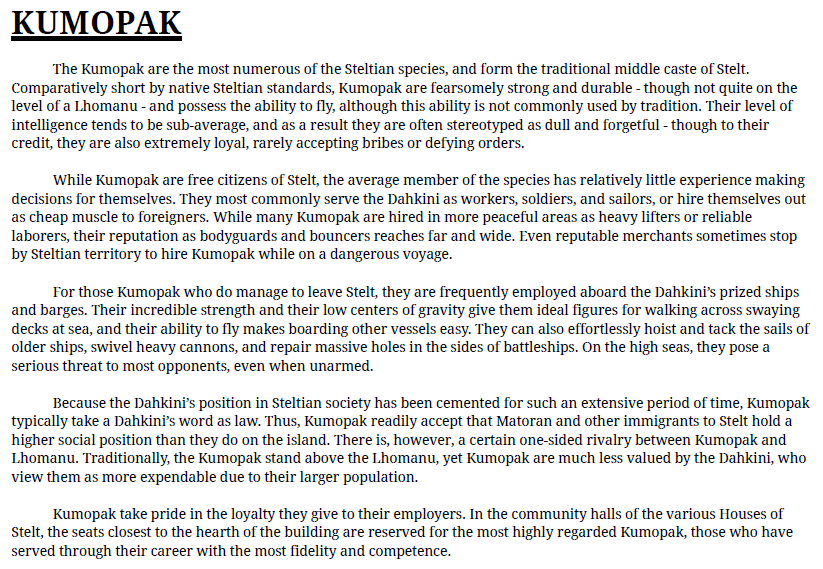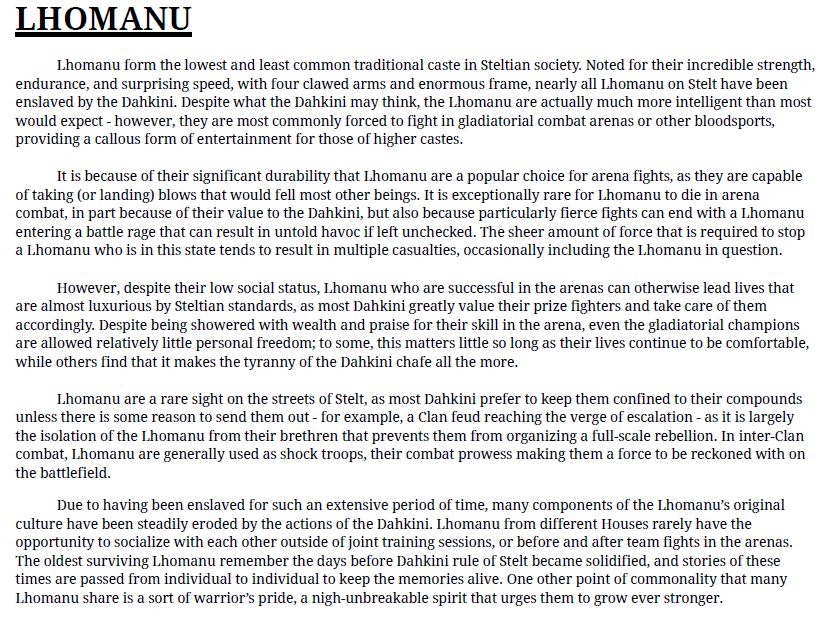Stelt, as we know, is a strictly hierarchical island-society. In some sense, it mirrors the structure of the Matoran: one’s (sub) species—Turaga, Toa, or Matoran—determines, with notable exceptions, the role and status of the individual within that society.
Turaga, supremely wise, occupy a leadership role. Toa, powerful and energetic, carry out necessary violence in the interests of Turaga and Matoran. Matoran, plentiful and diligent, do the labour.
Unfortunately, our knowledge of Stelt and its species is more limited. Sidorak/Voporak’s species—the Steltian Leader-Class (SLC), are clearly in charge, yet they do not all occupy positions of power. In Federation of Fear, an SLC is a simple trader; we do not see, in canon, similar instances of Turaga doing mundane work such as this. The proportion of Sidorak’s species which act in leadership roles, versus the proportion in mundane work, is unknown.
In part, it was the limited information on Steltian politics and social life which caused me to develop this idea; in part, it emerged from information we know well. In any case, here’s the idea itself: when the Great Beings created Stelt, Sidorak’s species did not occupy the uppermost echelon of the social hierarchy—they were subservient to another, now perhaps extinct species, the Original Leader-Class, before overthrowing it and seizing power.
The first inspiration for this, funnily enough, came in the form of the ‘fine-tuning argument,’ a real life argument often used to attempt to demonstrate the existence of a God; the argument essentially states that, as the existence of life seems so precarious and immensely unlikely in a purely chaotic or mechanistic universe, it must be that the universe has been intentionally, consciously fine-tuned to meet the demands of existence of earthbound life.
Of course, at the moment we aren’t interested in the value of such an argument in the real world… but the Matoran Universe, irrefutably, with certainty, has been designed in such a purposeful, particular manner. The Great Beings and Mata Nui created a world in which its life was fit to thrive and produce. The Turaga, Toa, and Matoran have a purpose, the Xians and Barraki have a purpose, the Skakdi have a purpose (and I’ll come back to the Skakdi soon), and, of course, the Steltians have a purpose.
Why, then, is Stelt described as “constantly on the edge of anarchy and total collapse”? Could it simply be that, unlike Metru Nui, Xia, Nynrah, etc., Stelt was poorly designed? More specifically, that the Ruling Class was poorly designed? After all, the full quote is as follows:
“The entire island was constantly on the edge of anarchy and total collapse, due to the constant infighting of Sidorak’s species.”
Or, this:
“The island was a desolate place, mostly due to the ruling species’ envy; whenever one of them managed to build any kind of structure, their neighbors grew jealous and united to tear it down.”
The blame is placed squarely on the shoulders of Sidorak’s species, and indeed, their traits seem not to be the traits of an ideal leader. Why would the Great Beings place this species in charge, especially when they have been so particular about this type of thing before (look at Orde and the Ce-Matoran!)?
Before moving on, I’ll address some counterpoints.
Counterpoints
(1) The Great Awakening: Some species were created, by the Great Beings, as a relatively limited consciousness—Matoran, for example, were intended to be much more robotic (though Toa, on the other hand, were always intended to be more independent), and it was Velika’s meddling which perhaps caused this disturbing and troublesome change in the personalities of Sidorak’s formerly reasonable species. They could have been suited for leadership before the Great Awakening changed them for the worse.
(1 Response): This is true, Velika did throw a wrench into the Great Being’s plans with the Great Awakening. However, this limited consciousness did not affect the Toa Mata, Hand of Artakha, and numerous other beings in positions of authority or decision-making. Matoran labourers may have been awakened by Velika, as, no doubt, were Krekka’s species, but the rulers of Stelt? Even if the great majority were, indeed, simple traders or workers, if some of Sidorak’s species held the levers of power on such an influential location as Stelt, their programming would need to be at least as dynamic as a Toa’s. For this reason, I don’t believe they were Awakened by Velika.
(2) Particular Species fail in their duty throughout the story—Makuta, the Barraki, and the Skakdi—and no similar theory can be applied to them. Why is Stelt a special case?
(2 Response): The Makuta are, of course, a special case, being built by Mata Nui—not by the Great Beings—to fulfill a role which might require or incite some bombast. They also differ in the sense that they do not possess the spirit of reckless jealousy or futile destruction; Sidorak’s species renders Stelt completely inert and a liability, whereas the Makuta’s turn did not, until quite later on, inhibit business in the same way. The turn was also a chance event, instead of an intrinsic characteristic—a human who kills, in premeditation, a trusted friend, is hardly comparable to the impulsive violence of a wild animal. I would apply the same rationale to the Barraki, who, coincidentally, were also Mata Nui’s doing, not the Great Beings’. An analysis of the Skakdi, once more, will have to wait; yet it can clearly be seen that Zakaz’s dysfunction flows from Spiriah’s influence, as opposed to that of their original creators.
(3) The Great Beings, in a more general sense, screw up all the time. They put the Element Lords in charge on Spherus Magna, made a mess of the Baterra, had faulty programming in individuals such as Karzahni or Tuyet… need I go on?
(3 Response) The most compelling qualm. The Great Beings are forever stumbling from one disaster to the next, so it is a reasonable point to make. Sidorak’s species’ complete inability to perform its designated function, of course, can be chalked-up as a result of the greater incompetence of the Great Beings; no concrete canon evidence points to the existence of a fourth Steltian species, and my intention is not to put forth an argument stating that this was the intent of the authors—it obviously wasn’t. The purpose of this argument is to provide an interesting, conflict-generating story idea which makes as much sense as possible. With that in mind, if we want this idea to be true—and I’ll provide some reasons why that might be the case—then even the most difficult cases can be simply explained away. Karzahni, for example, was an incredibly powerful and intelligent being bent entirely upon keeping his particular inadequacies hidden. Is it entirely implausible he managed to be successful in this endeavour, until the launch of the GSR? I don’t feel that it is. If, on the other hand, we wish to dispute this headcanon, cases can be explained against it: the Great Beings created Karzahni and he failed in his task; therefore, they created the Steltians with the same flaws. Anyone bent on arguing against it will be easily able to do so, as the argument is, of course, completely speculative.
Counterpoints (hopefully) addressed, here is the headcanon in more detail. The Great Beings created four Steltian Species—slave/gladiator/soldiers (Gladiator’s Species), Workers and Labourers (Krekka’s Species), administrators and specialists (Sidorak’s Species), and leaders (proposed fourth species). This fourth species functions as a sort of Turaga, one able to conduct Steltian affairs with wisdom and long-term strategy. Sidorak’s Species functions as a lower level administrator, but one which can nevertheless amass a fair amount of power and prestige. They are energetic and driven by an intense will-to-power, one which can generate necessary change and push the Fourth Species to its potential. This Species, in turn, tempers Sidorak’s species’ impulsivity with aforementioned wisdom and a sense of duty to Mata Nui. When the two are working together, Stelt is able to fulfill its task in keeping the GSR in operation; and for many years, the two species indeed work together to great effect.
However… the energetic and impulsive qualities which, under the thumb of wisdom can effect fantastic positive change, are the same qualities that, should they be untethered, precipitate political instability and societal disaster. Throughout the 100,000 years of history, the fourth species must remain vigilant to contain and direct this source of power. At one critical moment—invasion, bankruptcy, whatever— they falter. In that moment, the very-canon jealousy and treacherous nature of Sidorak’s Species takes hold, and the entire Matoran Universe is unwilling audience to an event (perhaps authored by you) known ever-after as the Steltian Revolution. Once-prosperous Stelt is plunged into civil war; the fourth species is annihilated in a genocidal frenzy, Sidorak’s Species seizes quickly disintegrating political authority, and, over the thousands of years between the Revolution and Stelt’s first story appearance, descends into the near-anarchic state for which it is known. All mention of this original leader class is scrubbed from history by zealous revolutionaries, in a manner not unlike the Barraki, and the machines which produced them are smashed beyond recovery. Various Great Powers—Metru Nui, Xia, Nynrah—grapple with the political implications of this upheaval (perhaps in a similar way the world reacted to news of the Bolshevik Revolution in Russia), compare the downfall with that of Zakaz, and observe, as various conflicts in the centuries to follow can be traced back to this dark nexus.
Stories and Myths resound throughout the Millennia. Was the extinct species hulking monsters, styled akin to the other three physically intimidating Steltian Species? Or frail, small? And—most importantly—did any escape?




